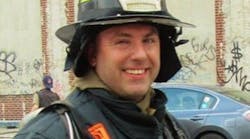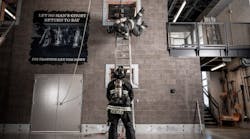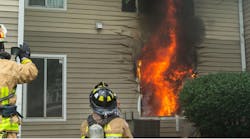PREPARATION:
Motivation:
Extinguishing a working chimney fire with PPV and a dry chemical extinguisher is a relatively easy task to perform. It eliminates the need for placing personnel in harms way with extended roof operations, especially during periods of inclement weather. Typical chimney fire operations take between 1-11/2 hours to mitigate. PPV and a dry chemical extinguisher will cut the extinguishment activity to 10-15 minutes because it is much less labor intensive.
Student Performance Objective (SPO):
The student will function as a member of an interior attack team, will extinguish a chimney fire using positive pressure ventilation, a dry chemical extinguisher, and the required hoselines in place from a fire department pumper to the satisfaction of the instructor.
Overview/Main Points:
• Chimney Construction Features
• Extinguishment
• Check for Extension
SESSION 1 Extinguishing Chimney Fires with Positive Pressure
Ventilation
SPO 1-1 The student will function as a member of an interior attack team, will extinguish a chimney fire using positive pressure ventilation, a dry chemical extinguisher, and the required hoselines in place from a fire department pumper to the satisfaction of the instructor.
Enabling Objectives (EO):
EO 1-1-1 Identify the characteristics of standard chimney construction and its relation to the interior/exterior of a structure.
EO 1-1-2 Apply the steps required to successfully extinguish a working chimney fire using PPV and a dry chemical extinguisher.
EO 1-1-3 Check for and prevent possible fire extension into an uninvolved structure during PPV operations.
Teaching Points
Opener: Call to order; start with a motivator (need to know) related to objectives; state objectives and main points.
I. Chimney Construction Features (1-1-1)
A. Masonry
1. Solid/waterproof modular concrete block, lined with a fire clay flue or fire clay brick
2. Uses refractory cement mixture to join brick and flue lining
3. Two-three inches is the rule of thumb air space clearance between the interior masonry chimneys
and combustible material
B. Metal
1. Single-wall metal chimney or unlisted metal shall not be used inside or outside one and two story
single family dwellings
2. May be used on a residential type or low heat appliance such as a pellet stove
3. Must be properly riveted, welded, or bolted, and properly secured to the structure
4. Must also have the proper clearance from structure to prevent pyrolysis
C. Factory built (zero clearance)
1. Pre-engineered and designed to function as a unit
2. Manufacturer provides a special starter section that locks into the collar at the top of the fireplace
3. When passing through combustible material, a fire stop spacer must be used as specified by the
manufacturer
D. Replacement (re-lining)
1. Consists of rigid and flexible stainless steel
2. Is placed inside of an existing flue, and surrounded by noncombustible insulations
E. Fireplaces consist of:
1. Cap
2. Flue
3. Mantel
4. Smoke Dome
5. Smoke shelf
6. Damper
7. Facing
8. Throat
9. Lintel
10. Firebox
11. Hearth
12. Ash pit
13. Foundation
II. Extinguishment (1-1-2)
A. Conduct a size-up in accordance with established SOPs (AHJ)
B. Conduct interior size-up of fireplace and upper/lower floor space in structure
C. Advance attack lines into first floor and upper floor(s) as directed and standby
D. If interior environment is smoke filled, monitor air samples for CO levels and don SCBA
E. Remove contents from firebox and extinguish outside of structure with water
F. Place PPV blower at appropriate door nearest fireplace and close off the rest of the house or door isolating fireplace room from rest of structure
G. Start up blower and run at 1/2 to full rpm as required to facilitate chimney drafting
H. Place dry chemical extinguisher hose in fireplace
1. Aiming it up the flue opening
2. Discharge the product in 1-2 second bursts
3. Be careful not to prolong this process as the product will be heavy and fall back down into the
firebox area
4. Monitor the drafting process while discharging the extinguisher
I. Place a spotter outside the structure to monitor product egress from the top of the chimney cap area
III. Check for Extension (1-1-2)
A. Send attack crews to upper floors and attic areas with charged hoselines, to ensure that extension has not occurred
1. No booster lines
2. No PW cans
B. Use a mirror device to check for flue extinguishment
1. Advise homeowner to have a professional chimney company come out to perform an inspection
before it is used again
2. Do not forget to clean up the mess before leaving a structure
Summary:
Student Performance Objective (SPO):
The student will function as a member of an interior attack team, will extinguish a chimney fire using positive pressure ventilation, a dry chemical extinguisher, and the required hoselines in place from a fire department pumper to the satisfaction of the instructor.
Review/Main Points:
• Chimney Construction Features
• Extinguishment
• Check for Extension
Evaluation:
Oral Review:
Under each review point, recall and list three features from the discussion. Make a note of these points or highlight points in your notes so you may use them for exam review.
Other Evaluation:
Instructor may use course quizzes, if any, or create and use lesson quizzes and other learning reinforcements. Quizzes are diagnostic and may be given as in-class group assignments to generate discussion or as home assignments and used as review prior to starting the next session.






